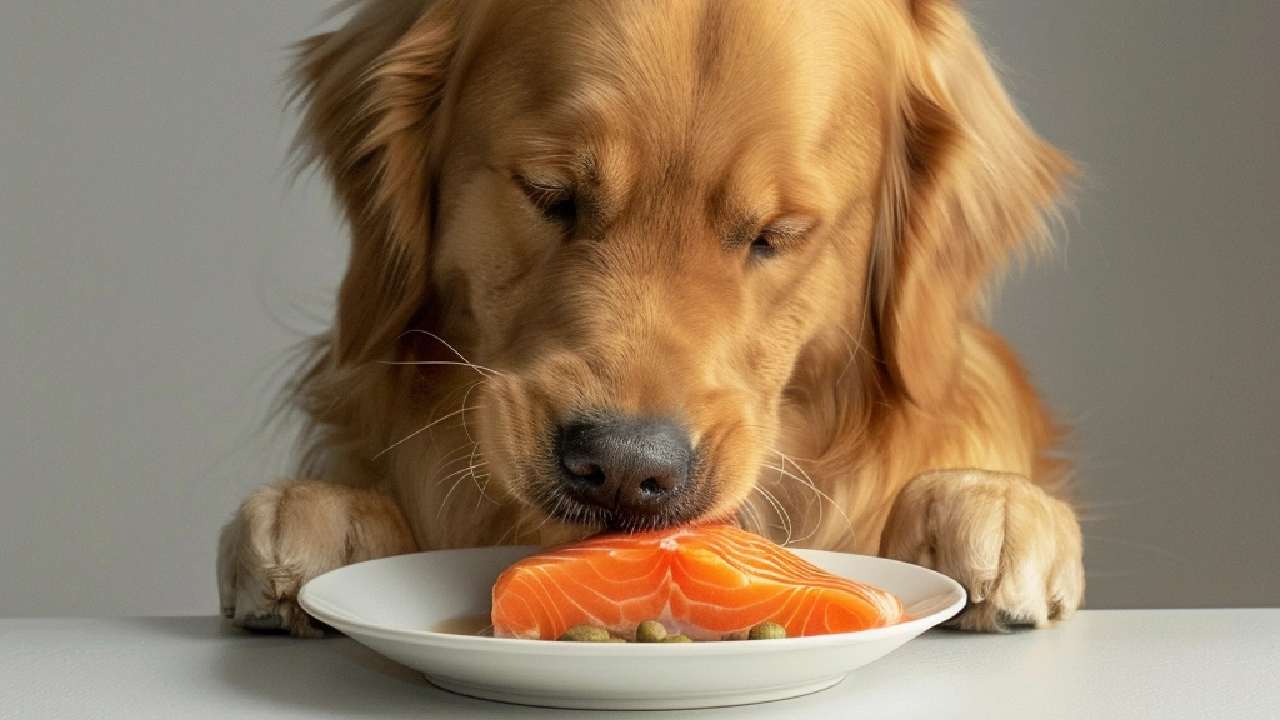When we welcome a furry friend into our homes, their well-being becomes our utmost priority. As a responsible pet parent, you’ll likely ponder every mealtime decision, considering your dog’s tastes and nutritional requirements.
Among the vast array of options, fish is a delicacy that captures our attention and our pooch’s curiosity. By the end of this journey, you’ll be equipped with a deeper understanding of providing a balanced and nourishing fish-based diet for your four-legged friend.
Can Dogs Eat Fish?
This question intrigues pet owners seeking to enhance their canine’s diet. The answer is yes, dogs can eat fish, but crucial considerations include the best types of fish that benefit their overall health and the risks associated with feeding them fish.
It is important to consult your vet and savor the joy of watching your furry friend relish a fishy delight.
“Fish shouldn’t be the main diet. Fish can be useful, but also harmful.” – Veterinarian Mykhailo Ozmenchuk.
Benefits of Fish for Dogs
Fish is an exceptional source of high-quality protein, essential for your dog’s muscle development, maintenance, and repair. The amino acids in fish protein support various bodily functions, ensuring your canine companion stays active and robust.
Omega-3 fatty acids, abundantly found in fish like salmon and mackerel, are essential for your dog’s overall health, providing many benefits from the inside out. These vital nutrients ensure the maintenance of healthy skin and a lustrous coat, helping to manage inflammation and reduce the risk of skin irritations for a shinier, smoother appearance. They also play a significant role in cognitive enhancement.
They support brain function, offering a cognitive boost that is especially beneficial for aging dogs to help maintain their mental sharpness.

The Risks Associated with Feeding Fish to Dogs
Fish bones can pose a significant risk to your dog. Sharp bones can cause choking, oral injuries, or even perforations of the digestive tract. It’s crucial to ensure that any fish you offer to your pooch is boneless or thoroughly deboned to prevent such hazards.
Allergies and Sensitivities
Just as humans can have adverse reactions to certain foods, dogs, too, can develop allergies or sensitivities that can affect their overall health and well-being. While offering numerous health benefits, fish is not immune to being a potential allergen for some dogs.
Symptoms can range from skin-related issues such as itching, redness, and rashes to gastrointestinal disturbances, including vomiting, diarrhea, and a lack of appetite.
If your dog experiences digestive issues after eating fish, it might be helpful to explore food for dogs with upset stomach for gentle dietary options.
Dogs may also exhibit behavioral changes such as excessive licking or scratching, which can indicate discomfort or an allergic reaction.
Parasites in Raw Fish
While incorporating fish into your dog’s diet has advantages, offering raw fish can pose significant health risks due to the potential presence of parasites.
To safeguard your dog’s health, cooking fish thoroughly before serving it is imperative. Cooking at appropriate temperatures kills harmful parasites, making the fish safe for consumption.
Feeding raw fish to dogs carries the risk of contamination with dangerous bacteria such as salmonella and listeria. This presents a dual threat: firstly, it poses a health risk to your dog, and secondly, as per the FDA’s research, it can also endanger you and your family members. This risk is particularly acute for small children, who are more likely to come into contact with the dog’s saliva, and for individuals with weakened immune systems, making it a concern for household health and safety.
Imbalanced Diet
While fish can provide valuable nutrients, relying solely on it as the main dietary component can lead to an imbalanced diet.
A balanced diet for dogs includes a variety of protein sources, carbohydrates, vegetables, and essential nutrients. Fish should be part of a diverse meal plan rather than the sole focus.

Choosing the Best Types of Fish for Your Pooch
Not all fish are created equal when sharing the aquatic delights with your furry friend. Selecting the best types of fish for your pup requires carefully considering their nutritional value and safety aspects.
1. Salmon: This fish is a crowd favorite for humans and dogs alike. Rich in omega-3 fatty acids, salmon supports joint health and contributes to a lustrous coat. However, ensure it’s cooked thoroughly to eliminate any potential parasites.
Raw salmon can contain parasites that lead to conditions such as salmon poisoning disease, which is potentially fatal if not treated.
Therefore, ensuring that salmon is thoroughly cooked is imperative for your dog’s safety and health, offering a balance of great taste and nutritional benefits.
2. Whitefish: Mild and easily digestible, whitefish such as cod and haddock can be a great protein source for your dog. They are low in fat and rich in B vitamins, making them a nutritious addition to their diet.
These fish are not only a fantastic source of lean protein, which is essential for muscle development and repair, but they are also low in fat, reducing the risk of obesity.
3. Tuna: While tuna is safe for dogs in moderation, opting for the “light” variety packed in water rather than oil is essential. Tuna is a protein powerhouse, but its high mercury content requires cautious feeding. An important consideration when feeding tuna to dogs is its mercury content; high levels of mercury can be harmful over time, potentially leading to mercury poisoning.
Therefore, tuna should be offered in moderation, serving as an occasional treat rather than a staple in their diet, ensuring your dog reaps the benefits without the risks associated with mercury.
4. Trout: A nutrient-rich choice, trout provides essential omega-3s, vitamins, and minerals. Bone-in trout can be problematic, so ensure it’s thoroughly deboned before serving.
Bones in fish can pose a choking hazard or cause internal blockages in dogs. Given the potential for unexpected health issues, it’s wise to consider dog insurance plans to ensure your furry friend is covered.
Avoid High Mercury Fish
Certain fish, like swordfish and king mackerel, have elevated mercury levels, which can harm dogs over time. To prevent potential health issues, it’s best to avoid these varieties.
The ingestion of high levels of mercury can lead to mercury poisoning, which in dogs, as in humans, can cause a range of health issues. Symptoms of mercury poisoning in dogs include loss of coordination, visual impairment, tremors, vomiting, and, in severe cases, kidney failure or neurological damage.

Tips for Introducing Fish into Your Dog’s Diet
Introducing a new food into your dog’s diet requires a gradual and thoughtful approach:
- Start Small: Begin with a small portion of cooked fish to gauge your dog’s reaction. Monitor for any adverse effects, especially if it’s their first encounter with fish.
- Cook Thoroughly: Cooking fish eliminates the risk of parasites and makes it easier for your pooch to digest and absorb nutrients.
- Avoid Seasonings: Keep it simple: Avoid adding spices, seasonings, or excessive salt. Plain, unseasoned fish is the way to go.
- Incorporate into Meals: Mix a small portion of fish with your dog’s regular food to ensure a balanced diet.
- Observe Responses: Watch for any signs of allergies or sensitivities. Consult your vet promptly if your dog experiences digestive issues or skin reactions.
To sum up, incorporating fish into your dog’s diet should be done thoughtfully and in moderation as part of a balanced nutritional plan tailored to their health needs and dietary requirements.
Always consult a veterinarian before significantly changing your dog’s diet to ensure you provide the best care for your furry friend. Discover more about which people’s food can or can’t dogs eat to ensure a safe and healthy diet for your pet.

FAQ
How often can I safely include fish in my dog’s diet?
You can incorporate fish into your dog’s diet once or twice a week to ensure they receive its nutritional benefits without overexposure to potential allergens or high levels of certain minerals like mercury. Consider the balance of your dog’s overall diet and consult a veterinarian for personalized advice.
Can I feed my dog canned fish?
Dogs can eat canned fish, but it should be in water, not oil, without added salt or spices. Canned salmon, sardines, and tuna in water can be convenient options, but moderation is key due to their higher sodium content than fresh fish.
What precautions should I take when preparing fish for my dog?
Ensure the fish is thoroughly cooked to kill parasites and remove all bones to prevent choking or internal blockages. Avoid adding oils, butter, seasoning, or sauces, as these can upset your dog’s stomach or contribute to unhealthy weight gain.
Is it safe to feed my dog fish skin?
Fish skin can be safe for dogs if it’s from a safe fish and has been thoroughly cooked to eliminate parasites. However, watch for any signs of stomach upset or allergies, as some dogs may have sensitivities.
How do I know if my dog is allergic?
Signs of a fish allergy in dogs include itching, redness, skin rashes, gastrointestinal upset, and excessive licking. If you notice these symptoms after introducing fish to your dog’s diet, consult your veterinarian for an evaluation and dietary advice.
Can feeding fish to my dog replace commercial dog food?
While fish can be a healthy part of your dog’s diet, it should not replace a balanced commercial dog food formulated to meet all of a dog’s nutritional needs. Fish can be used as a supplement or treat alongside their regular diet, ensuring they receive various nutrients.
It’s equally important to be cautious about the types of fish you choose, steering clear of high-mercury varieties like swordfish and king mackerel to prevent mercury poisoning.






My dog loves fish, but I wasn’t sure about including it in his diet. Your article provided helpful insights! 🐟🐾